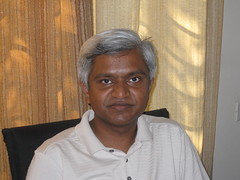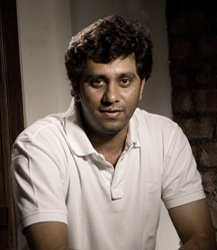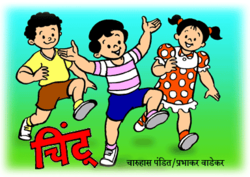(The Harbinger Group is a Pune-based software company that has products in the e-Learning space (http://harbingerknowledge.com), and also provides software outsourcing services (http://harbinger-systems.com) to software product companies all over the world. As an example of a successful product company out of Pune, as an example of a company that managed to do both, products and services, and as an example of a company that uses latest technologies in a hot field (e-learning), we felt that PuneTech readers would find it interesting. This article is based on a conversation Navin Kabra and Amit Paranjape from PuneTech had with Vikas Joshi, CEO of Harbinger)
The Harbinger Story
Harbinger was started in 1990 as a software services company. Vikas had just returned after doing a Masters in Computer Science from Syracuse in the U.S. and was a visiting faculty at the University of Pune. He, along with Swati Ketkar (one of his students) were the cofounders of Harbinger.
They started “Intelligent Tutoring Systems” and Agrawal Classes was their first customer. The first 10 years, they grew very slowly, with customers mainly in Pune/Mumbai, and only a few in Bangalore/Delhi. By 2000, they had grown to 28 employees. This was a period when they learnt the basics of how to do business, slowly and painfully.
In these early years, they were mainly helping companies with building CAD automation, and other systems that help in the engineering lifecycle. A few of their projects involved the use of computers/multimedia in training. Around this time they created their own product, CBTPro (Computer Based Training), which, in 1998, won MCCIA’s prestigious Parkhe Award (given to companies with the most interesting new products and ideas). From this point onwards they really started growing fast, both on the services side as well as the products.
From the beginning, while Harbinger was focusing on domestic customers, the Indian IT industry had been heavily involved in “body-shopping” (i.e. sending Indian programmers to the US for outsourced (but on-site) work). Harbinger were very clear that they did not want to do this. By 1999-2000 internet in India had advanced to a stage where it became clear that it would be possible to take on outsourcing work from the US without the need for programmers be moved to the US. This is when, after 10 years of existence, Harbinger went international. From that point on they have grown their international business to a point where the Indian market is now an insignificant part of their revenues.
Their services business has 300+ employees, and their portfolio is in these major areas: e-learning, web development, testing, and mobile development. Microsoft is a major customer.
Harbinger’s products are described in more detail in the next section.
Harbinger’s Products
While services business was being built up, product business (CBTPro and e-learning) was going well in India. In 2002 they actively started exporting the products.
Their product business started based on a pattern they were seeing in their services business. They noticed that existing e-learning solutions were not interactive. In terms of technology, it was clear that adding Adobe Flash to e-learning products would easily give the required interactivity – but there was big gap in the industry between instructional designers and flash developers. Flash developers were engineers who were not good at designing instructional content, and instruction designers did not have enough programming skills to be able to create content in Flash.
This led Harbinger to their Raptivity product line. Basically, Raptivity is an interactivity building tool, which includes a huge library of ready-made interactions, which can be used by non-technical people to quickly add interactivity to e-learning content.
The main customers of Harbinger’s products fall in these segments: US High-tech companies, US Traditional Companies, US Educational/Non-Profit/Government organizations, Europe, Asia-Pacific, and India-MiddleEast-Africa.
Some interesting drivers of Harbinger’s success
One major decision that Raptivity took early on, was that they would make it work with other authoring tools (not just Harbinger’s authoring tool). This was a key decision, which reduced the barrier to entry for customers. As a result of this decision, they have to stay in close contact with various authoring tools (including new ones), and work with them to integrate Raptivity. In the process of interacting with the vendors of any authoring tool, they are very open about disclosing Harbinger’s own authoring tool.
Another important area is the sales channel. Harbinger has its own sales force, but also sells a lot through resellers and other channel sales. One major mistake many companies make when using channel sales, according to Vikas, is to think of the sales channel as an external entity. Much better results can be obtained if you think of them as a part of your team. What does this mean? Include them on road-trips, conferences, and education about your products. The channel employee assigned to you should be treated as your salesperson. Because he is your salesperson.
A third area that a products company needs to be aware of is that the value proposition for a sales channel, and the value proposition to the end customer are two different things. Sometimes they are aligned, but sometimes, they can conflict. So, both need to be managed separately.
This means that the various sales channels should be segmented carefully, and the company should create unique product offerings for each channel. For example, in case of Harbinger’s products, one channel is Training System Integrators, and these vendors are interested in building the most comprehensive and feature rich system possible. They are not as interested in margins as they are interested in the fact that your products should be cutting edge and should have all the important features. By contrast there are “box pushers” (hardware vendors) who are more interested in margins and volumes. A third category of resellers is companies who wish to be seen as thought leaders, influencers and visionaries. Their motivations on selling your products is very different from those of the previous two categories.
Thoughts on Future Trends in e-Learning
Vikas believes that the primary pain point that they were focusing on (i.e. allowing e-learning authors to easily incorporate interactivity in their systems) is now a solved problem. The next challenges will come from these areas:
- Touch Tablets: Touch tablets are likely to have a profound impact on this industry. Not only does this give rise to a wide variety of screen sizes and hardware capabilities (which was rather limited in the PC/Desktop days), but also the fact that touch is a fundamentally different form of interaction.
- For example, a customer recently rolled out 1500 iPads to their entire sales force and would like the desktop/laptop e-learning products “ported” to the iPad. However, iPad is a very different beast, with a different paradigm. A simplistic port will fail. It needs to be re-thought from the ground up and a completely new offering needs to be released for this market.
- Harbinger believes it is well positioned to play in this space because of their research on interactivity (and a couple of patents they have in this area)
- New forms of interactivity. With Kinect and other forms of interactivity becoming a reality now, very soon, there will be an opportunity to use them in e-learning/training systems
- Testing the limits of what is possible. For example, one person used Harbinger’s products and created 250 courses over 5 years and trained 20,000 users. A huge impact possible by doing such things – as compared to traditional training. There is an opportunity for e-learning technology companies to provide more and more tools to make such things possible.
- Using e-learning/interactivity concepts in other areas: Capabilities of human-computer-interface systems are the plumbing. Interesting products are possible if we use the latest plumbing and build the most interesting, compelling, and impactful interactive products on top of it. Examples:
- Classroom Training
- Every student has a internet connected device
- And can be used to enhance class participation
- And the presentation changes based on participation
- Richer business presentations
- Using a Raptivity-like technique in presentations (PPT)
- e.g. interactive graphs pack
- Don’t show all information at once
- Bring relevant information up via interactivity
Thoughts on the Indian Market
Right now, the Indian Market for technology products is very small. As mentioned earlier, it makes up for a small fraction of Harbinger’s revenues even though Harbinger started off as a purely domestic company. However, Vikas points out that the Indian Market is still extremely important. Without Indian market, Harbinger wouldn’t have gotten started, and the first trip to US was only possible due to the sales in the Indian market. Also, for the future, Vikas is extremely optimistic about the Indian Market. Things are changing so rapidly here, so while he is not sure of when exactly it will take off, but take off it will.
Advice to Young Entrepreneurs
Vikas writes a blog at http://teamharbinger.blogspot.com where he regularly gives advice based on his experiences. He points out though that his advice would be applicable only to people who are not more than 10 years younger than he is. Basically, someone who is very far ahead of you (and age is a very rough indicator of this), should no longer be considered a subject matter expert in the challenges you face, since they’ve forgotten what it was like to be in your position.
An important point Vikas makes is that the patterns of entrepreneur mistakes – haven’t changed in 20 years. The biggest one is that early entrepreneurs (especially the technology entrepreneurs who abound in Pune) tend to focus too much on the product itself and the features of the product. It takes quite a while for them to transition to the next stage of entrepreneurship – which is to be able to see their offerings not in terms of products and features, but in terms of benefits that customers get from using their products. During the sales process, the entrepreneur needs to clearly be able to articulate the benefits, and this is the most important thing for an fresh entrepreneur to learn.
The next step for an entrepreneur is to be able to transition from simply talking about the benefits of using their products, to creating or painting a vision of experiences for the customer. A 43-year old accountant wants to zip through downtown on a motorbike. Is there anything in your product that gives him a fraction of that experience. How do you give your customer that feeling? This is a very advanced art, and the ultimate goal for an entrepreneur.


![Reblog this post [with Zemanta]](http://img.zemanta.com/reblog_b.png?x-id=1e465248-0bf6-47a9-a176-0e8efa524b60)

![Reblog this post [with Zemanta]](http://img.zemanta.com/reblog_b.png?x-id=dcc84d57-62be-4f8c-91f4-0198c4c7a102)






![Reblog this post [with Zemanta]](http://img.zemanta.com/reblog_b.png?x-id=bbdc62dc-5b19-43b6-8a07-5746a2cfb23e)

![Reblog this post [with Zemanta]](http://img.zemanta.com/reblog_b.png?x-id=d1ca606d-fe9c-40fc-8e96-f96069defbaa)
